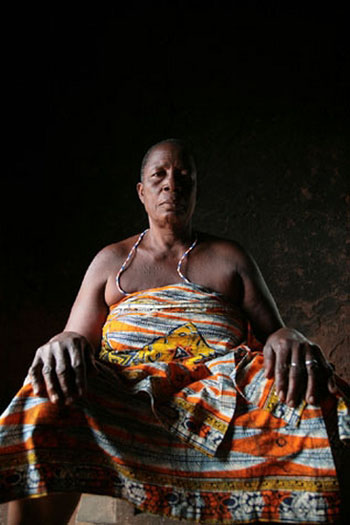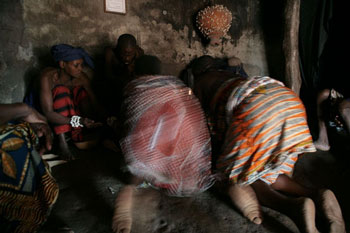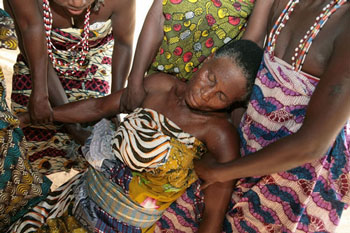"What's your mission?" is a question Ghanaians will ask when you visit their home or village. Unfailingly polite, it's the Ghanaian way of finding out why you have arrived and how they can help. My mission in Ghana was to photograph a traditional African religious practice in which women, usually virgins, are given to fetish priests as a form of reparation for a crime committed by a member of their family. The women are known as trokosi, which means "wives of the gods." The practice is a source of much controversy.
 |
Minawo, a trokosi from Togo, who came to pay her respects to a shrine in Ghana, in July, 2006. Trokosi are women who are given to a traditional shrine as a form of reparation for a crime committed by a member of their family. They must serve the shrine for the rest of their lives. Peter Pattisson |
Human-rights activists argue that it is a modern form of slavery; the women are forced to serve the shrine, often from a very young age, and there are well-documented cases of forced labor and sexual abuse. Traditional religious groups, however, claim it is nothing but a benign custom. The Afrikania Mission, an organization that represents most of the fetish shrines in the Volta region of Ghana where the practice is found, champions the cause of the traditionalists. Unsurprisingly the Afrikania Mission jealously guards its shrines from journalists. I knew, therefore, that to accept the mission to photograph the practice would be a challenge. I just didn't realize that it might be "mission impossible."
Day 1:
I rent a wreak of a car and drive east for three hours from the capital, Accra, to the Volta region. On the way I stop in the village of Battor. Battor is a community that practices traditional African religion and I had made an acquaintance here on a previous visit to Ghana. Not all traditional religious shrines have trokosi, so my first challenge was to try to find out whether there were any such shrines in the village. The only problem was I couldn't ask directly because the answer would have been an immediate "no." After a couple of hours of discussion I am still unable to confirm whether there is a trokosi shrine in the village, so I arrange to return at another date.
 |
Two trokosi bow before a shrine in the Volta region of eastern Ghana. Trokosi are often subjected to hard labor and sexual abuse. Peter Pattisson |
Day 2 & 3:I spend a couple of days in a remote village called Ehi under the pretext of learning about traditional African religion. I eventually ask whether there are any trokosi in the village and my host introduces me to four women. However, when I interview them, they are very positive about the practice. "We are proud to be trokosi," they say. I don't feel I'm getting the whole story.
Day 5:
I return to Battor, where they have promised to introduce me to trokosi. It quickly becomes clear that they are only willing to do so at a price. When they mention one of the shrines they are planning to take me to, I decide to risk going there on my own. Two hours later I arrive at the village of Agave and a local offers to take me to the shrine. We cross a small river and the priestess in charge says I'm welcome to photograph, but not today. Come back next week.
Day 7:
I make my second visit to a shrine in the village of Afife. This is the first shrine that actually has trokosi who will let me photograph. Before they will do so, however, I have to be initiated into the shrine. I take off my shirt and shoes and wrap a cloth around my waist. First they wash me in holy water and then tell me to bow before the gods. I knock back the customary glass of schnapps they give me and offer a small donation to ensure their cooperation. In rural Ghana, however, there is no concept of documentary photography and they want me to photograph them posed as a group in front of the shrine. I manage to persuade them to let me photograph them one by one, but there's no chance for interviews. The priest has told me that I may not photograph in the shrine itself, but when I follow him into the dark room I crank up my ISO setting and snap two frames of trokosi bowing down in front of him before he tells me to stop. Seven days in and I've got my first pictures.
 |
Ceceiliah Yegbe, a trokosi at a shrine in Avenorpeme in eastern Ghana, falls into a trance, possessed by the gods. She is supported by other trokosi. Peter Pattisson |
Day 8:I drive for three hours back to Accra to ask the leader of the Afrikania Mission for permission to photograph at a shrine in a village called Klikor, which is one of the largest trokosi shrines in the Volta. I wait an hour for him. Within minutes of meeting me he rejects my request outright.
Day 9:
I have been told that there are trokosi shrines in the villages of Big Ada and Old Bakpa. I drive for two hours to Big Ada and find nothing. On the way to Old Bakpa my exhaust falls off. I put the whole length of it in my car and drive the rest of the way with it sticking out the window. I hire a canoe and paddle across the Volta River to reach Old Bakpa. "Yes, we do have trokosi," they tell me, but they are not here today. I drive three hours back to Battor and after patient negotiations manage to photograph one trokosi in a shrine there. It's my fourth visit to the village.
Day 10:
I follow another lead to a shrine at Avenorpeme. On the way the police stop me and threaten to take me to court for not having a fire extinguisher in my car. I wait till they ask me for a bride and then threaten to report them. They let me go. The priest at Avenorpeme invites me back to photograph the next day.
 |
Nanaghoe Akpobi, a liberated trokosi, Volta Region, Ghana, July 2006. Peter Pattisson |
Day 11:I arrive early in the morning and photograph a ceremony of drumming and dancing. One of the participants falls into a trance, possessed by the gods. It's a unique experience but I am not even sure that these women are trokosi.
Day 12:
Although the Afrikania Mission has refused me permission to photograph at Klikor, I decide to approach the shrine directly. I am introduced to the priest and despite my offer of a "generous donation" he insists I get permission from the Afrikania Mission. On the way back my exhaust falls off again.
Day 13:
I drive back to the shrine at Agave, anticipating that I will finally get the chance to photograph. It's raining hard and I slip and fall in the mud. The priestess, I am told, has had to leave for an important event and unfortunately I cannot photograph without her. I argue for an hour before being politely led away. Two young boys follow me and quietly tell me that the priestess is actually in the shrine and is hiding from me. It transpires that the Afrikania Mission heard of my planned visit and told the priestess that under no circumstances was I to be allowed to photograph. The rain hasn't stopped and the dirt road back to my hotel is now a river of mud. My car slides into a ditch but I manage to edge out of it and make it back.
Day 14:
It's my last day and I decide to return to the shrine at Avenorpeme. I am pleased with the photos I took there earlier in the week and I suspect that some of the women I photographed there are trokosi, but I need to confirm it. In 14 days in the Volta I have made 18 visits to 10 shrines, driven almost 1,000 miles and photographed trokosi for not more than four hours. When I arrive at the shrine a member of the village assures me that all the women I photographed are, indeed, trokosi. Mission accomplished.
Until March 2006, Peter Pattisson was a full-time teacher and a part-time photojournalist, squeezing in documentary projects during the school holidays. Over a number of years he was able to develop a reasonable body of work, but always at a price; on a Friday he would be photographing in a remote part of the world and on Monday, teaching in inner-city London. So he decided to give photography all his attention and chose to work on a project to photograph contemporary forms of slavery around the world, on the eve of the bicentennial of the abolition of the slave trade by the British Parliament. Since 2001 Pattisson's work has been published in a wide range of magazines and newspapers. He has also worked with a number of NGOs, including Save the Children, Anti-Slavery International, CARE International and Comic Relief. Pattisson held his first exhibition of documentary photography from Afghanistan, Sri Lanka and India in London in 2003. Peter Pattisson is represented by ZUMA Press.





